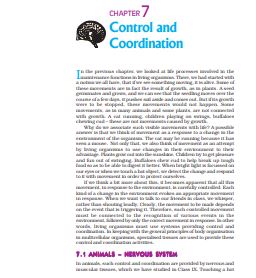‘NCERT Solutions for Class 10 Science Chapter 7‘ PDF Quick download link is given at the bottom of this article. You can see the PDF demo, size of the PDF, page numbers, and direct download Free PDF of ‘Ncert Class 10 Science Chapter 7 Exercise Solution’ using the download button.
NCERT Class 10 Science Textbook Chapter 7 With Answer PDF Free Download

Chapter 7: Control and Coordination
In the previous chapter, we looked at life processes involved in the maintenance functions of living organisms.
There, we had started with a notion we all have, that if we see something moving, it is alive. Some of these movements are in fact the result of growth, as in plants.
A seed germinates and grows, and we can see that the seedling moves over the course of a few days, it pushes soil aside and comes out.
But if its growth were to be stopped, these movements would not happen. Some movements, as in many animals and some plants, are not connected with growth.
A cat running, children playing on swings, buffaloes chewing cud – these are not movements caused by growth.
Why do we associate such visible movements with life? A possible answer is that we think of movement as a response to a change in the environment of the organism.
The cat may be running because it has seen a mouse. Not only that, but we also think of movement as an attempt by living organisms to use changes in their environment to their advantage.
Plants grow out into the sunshine. Children try to get pleasure and fun out of swinging. Buffaloes chew cud to help break up tough food so as to be able to digest it better.
When bright light is focused on our eyes or when we touch a hot object, we detect the change and respond to it with movement in order to protect ourselves.
If we think a bit more about this, it becomes apparent that all this movement, in response to the environment, is carefully controlled.
Each kind of change in the environment evokes an appropriate movement in response. When we want to talk to our friends in class, we whisper, rather than shout loudly.
Clearly, the movement to be made depends on the event that is triggering it. Therefore, such controlled movement must be connected to the recognition of various events in the environment, followed by only the correct movement in response.
In other words, living organisms must use systems providing control and coordination. In keeping with the general principles of body organization in multicellular organisms, specialized tissues are used to provide these control and coordination activities.
| Author | NCERT |
| Language | English |
| No. of Pages | 13 |
| PDF Size | 724 KB |
| Category | Science |
| Source/Credits | ncert.nic.in |
NCERT Solutions Class 10 Science Chapter 7 Control and Coordination
1. What is the difference between a reflex action and walking?
Solution:
Reflex actions are involuntary actions that occur in response to stimuli. They occur without the involvement of conscious areas of the brain. All the reflex actions are unconscious actions. Reflex action occurs brain and spinal cord of the central nervous systems.
On the other hand, voluntary actions are those which occur under the control of the cerebellum of the brain Walking is learned as we grow. Walking is controlled by the brain and is used when required.
2. What happens at the synapse between two neurons?
Solution:
Between the synapse between two neurons, electric signals are converted into chemicals that can easily cross over the gap and pass on the chemical messenger to the next neuron where it is converted back to the electrical signal.
3. Which part of the brain maintains the posture and equilibrium of the body?
Solution:
The cerebellum which is a part of the brain is responsible for controlling the motor functioning hence it is the part reengaged in the maintenance of posture and equilibrium of the body.
4. How do we detect the smell of an agarbatti (incense stick)?
Solution:
The smell of an agarbatti is detected by the nose, olfactory receptors present in the nose send an electrical signal to the forebrain. The forebrain interprets this signal as the incense stick to be detected as smell.
5. What is the role of the brain in reflex action?
Solution:
Reflex actions are formed instantaneously in response to the stimulus that has no time to think. For instance, the sensory nerves that detect heat are connected to the nerves that move the muscles of the hand.
Such a connection of detecting the signal from the nerves (input) and responding to it quickly (output) is known as a reflex arc.
Reflex actions are generated in the spinal cord and the information also reaches the brain.
This helps the brain to record this event and remember it for future use. The brain helps the person to get aware of the stimulus and prevent himself from that situation again.
Control and Coordination NCERT Textbook With Solutions PDF Free Download
